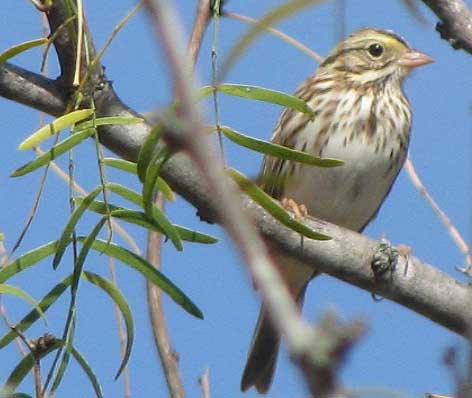Excerpts from Jim Conrad's
Naturalist Newsletter
from the November 25, 2012 Newsletter issued from the valley of the Dry Frio River in northern Uvalde County, southwestern Texas, on the southern border of the Edwards Plateau; elevation ~1750m (~5750 ft); N29.62°, W99.86°; USA
SAVANNAH SPARROWS
In the dun-colored ocean of foot-high Big Bluestem grass blanketing the floodplain of the Dry Frio River there are lots of quick, little, brown birds who fly up like scared grasshoppers when you approach, then just as fast drop back into the grass a bit farther away. But one day this week, instead of immediately plummeting back into the grass, one flew into a nearby Mesquite tree and perched long enough to have his picture taken, as shown below:

He's a Savannah Sparrow, overwintering in this part of the world after recently migrating from the species' nesting grounds in Canada and the northern US. The species also is a permanent resident on the West Coast but, this far east, the one in the picture certainly has flown from far to our north.
At first glance, seeing the big central spot on his chest, I thought he was a Song Sparrow. But then I noticed the flush of yellow between the eye and upper part of the beak -- the "yellow lores" -- and along with the deeply notched tail, that made him a Savannah. Interestingly, my dog-eared 1966 Robbins Birds of North America field guide specifically states that Savannah Sparrows bear no central spots on their breasts, but other works say that usually they do.
I suspect that other species of quick, little, brown sparrows are out in the grasslands so I intend to keep photographing whatever pops up. Already, just knowing that we have Savannah Sparrows here somehow makes the grass ocean around me feel even more congenial than it already does.
from the March 23, 2009 Newsletter, issued from the forest near Natchez, Mississippi; elevation ~400ft (120m), ~N31.47°, ~W91.29°:
SAVANNAH SPARROW APPROACHABILITY
At St. Catharine National Wildlife Refuge just south of Natchez this week I was way out on a levee barely rising above vast, silvery-surfaced, flooded fields on both sides of me. I was the most conspicuous feature on the landscape for miles around, so maybe that's why a certain little sparrow came to run and hop along the water's edge beside me as I hiked down the levee.
When I stopped he stopped and when I went on he continued running beside me, about ten feet away. His breast was so heavily striped that at first I thought he was the common Song Sparrow, who overwinters here, but I'd never seen a Song Sparrow behave like this. Once I got my camera focused, immediately I saw the yellow eyebrow, and I knew he was a Savannah Sparrow, PASSERCULUS SANDWICHENSIS.That's him below:

In that picture mud on his beak distorts the beak's apparent shape. Mudless, his beak is short and pointed the way a sparrow beak is supposed to be.
Savannah Sparrows are one of those species you don't usually see if you don't visit some fairly wild habitats; I've not seen them beneath birdfeeders or in the suburbs. However, they're fairly common birds in open country, the field guide mentioning hay meadows, marshes and tundra. They overwinter throughout the southern US south to Honduras and nest throughout northern North America from the highest Arctic south to about Utah and Illinois. In the east they seem to be declining in numbers, supposedly because of the trend for abandoned open farmland to revert to forest, but in the west they'e enjoying a slight population increase because of increasing deforestation and intensive agriculture.
The Smithsonian Field Guide applies the interesting adjective "approachable" when describing this species. This makes me believe that I'm not the only birder who has been astonished by the bird's apparent attraction to, or at least tolerance for, roving humans.